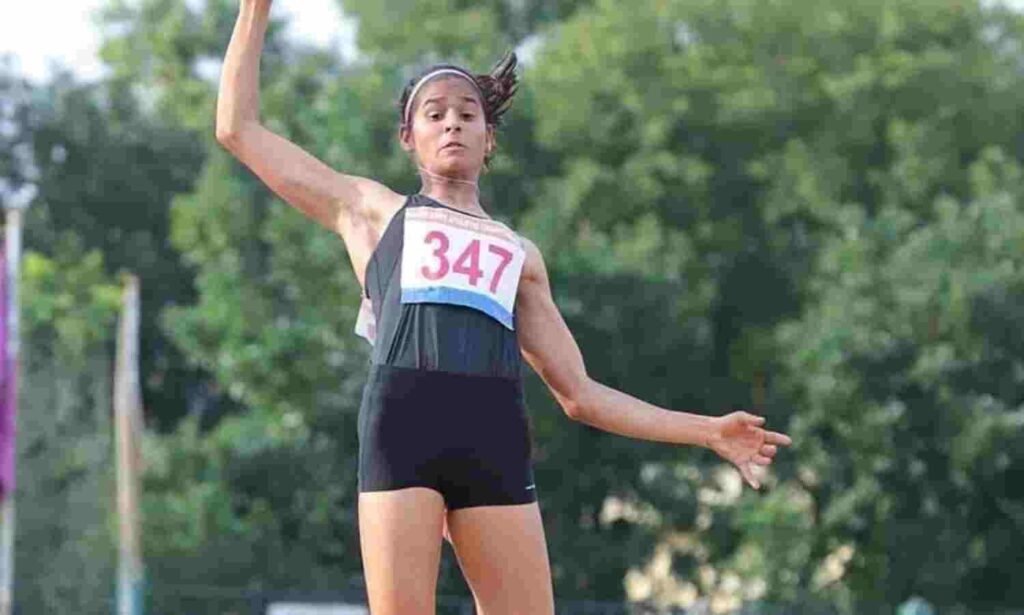
It makes for great watching, the image of Shaili Singh coming face to face with the Shaili Singh she can be – a girl with the courage to perform, who takes responsibility for her actions, who is high on motivation without needing external trinkets, and who manages her emotions. And we saw these come together as she nailed the second-longest leap by an Indian woman athlete.
Her 6.76m effort on Saturday ranks 157th in the world in the women’s Long Jump list since the dawn of the new millennium in 2001. To get some perspective, her mentor Anju Bobby George’s 6.83m at the Olympic Games in Athens in 2004 places her 97th in that list. If the time frame is shrunk to the last five years, Shaili is among the world’s top 60.
Having said that, it may be of greater significance to Indian fans that only Uzbekistan’s Darya Reznichenko has leapt farther than Shaili among Asian women long jumpers in the last five years. She can be a medal favourite at the Asian Games. And if she replicates or improves her performance, gold can be hers 21 years after her mentor won the Asian Games crown in Busan.
Let me address a question that may have surfaced now: Why did I choose the dawn of the new millennium and not look at an all-time list that spans a bit more than 100 years? Galina Chistyakova’s world record of 7.52m was set on June 11, 1988. Nobody in the last 12 years has come within 20cm of that in an event where there has been a decline in standards globally.
Shaili, the Jhansi girl who is based in Bengaluru, will now have to prepare to deal with two pressure points that will surface soon. First, there will be questions on the 7m barrier. Secondly, she will be reminded that most of those who have done well at the junior level in global competitions have not even made it to, let alone succeeded in, senior competitions.
To be sure, it will not be long before she is asked questions about the 7m mark, just as Neeraj Chopra is constantly asked about throwing the javelin beyond the 90m mark these days. While barrier-breakers live with such questions, it is critical that she is left alone to enjoy her sport and, with her coach Bobby George, plot ways to embrace consistency, reduce the risk of injury and get better.
Bobby George and Anju Bobby George have always spoken of Shaili as the one who would break Anju’s national record, 6.83m, set on August 27, 2004, at the Olympic Games in Athens. They did not doubt that, let alone revise it, even in the wake of an injury that kept Shaili away from the World Athletics U-20 Championships in Cali, Colombia, last year.
It does not need them to tell us that we are talking about a hungry girl. There was evidence at the Sree Kanteerava Stadium in the AFI Indian Grand Prix 4 where she made her maiden appearance this year. On a runway that was cleaned, as Anju Bobby George revealed, by the coach himself and others, Shaili demonstrated the rare quality of not easing off after the gold was won.

She opened with a career-best leap of 6.58m. And instead of relaxing, as most would, she pushed for a longer jump. A foul on her second try was followed by the 6.76m effort. Shaili did not take things easy even after this. She gunned for Anju’s National record. And, even as others sought to get past the 6.50m mark, she added two valid jumps of 6.64 and 6.66.
It is this eagerness to make the most of the rhythm and see if she could script the longest jump by an Indian woman that marks her as a special talent out to discover unchartered territory. There was no question of pulling up the handbrake of satisfaction, and she continued to press the pedal in search of that record.
There is a packed international calendar this year. The Asian U-20 Athletics Championships in Yecheon, Korea, from June 4 to 7, and the Asian Games in Hangzhou, China, from September 23 to October 8 will be the major stops. And Shaili may well pick up valuable experience at the World Athletics Championships in Budapest, Hungary, from August 19 to 27.
Of all her Indian predecessors as World Athletics U-20 Championships medallists, only Chopra has succeeded in also winning a global medal in the senior ranks. And Seema Antil in the discus throw is the only other U-20 global medalist from India who qualified for the World Athletics Championships.
This is true not just for Indian athletes, but globally. Studies have found that only a small group of track-and-field athletes that are successful in the U-18 and U-20 age groups become successful at senior level. Only 23.5 per cent of successful track-and-field athletes (ranked in the top 100) at U-18 level became successful senior athletes, while the U-20 group saw a 35.4 per cent success rate.
There is no reason Shaili cannot be in the group of such athletes. Even before she turned 19 in January, she found joy in being a World Athletics U-20 Championships medalist and a winner of the National Inter-State Athletics Championships. There was also the agony of spending time away from training and competitions due to Covid-19, a back injury and a toe fracture.
Irrespective of whether Shaili breaks the 7m mark or not, her greater challenge will be to medal in a global competition – the World Athletics Championships or the Olympic Games. Time is on the side of the teenager and her fans. Supporters and benefactors will have to learn patience in what is an extremely technical event that combines speed, timing and the ability to defy gravity.



